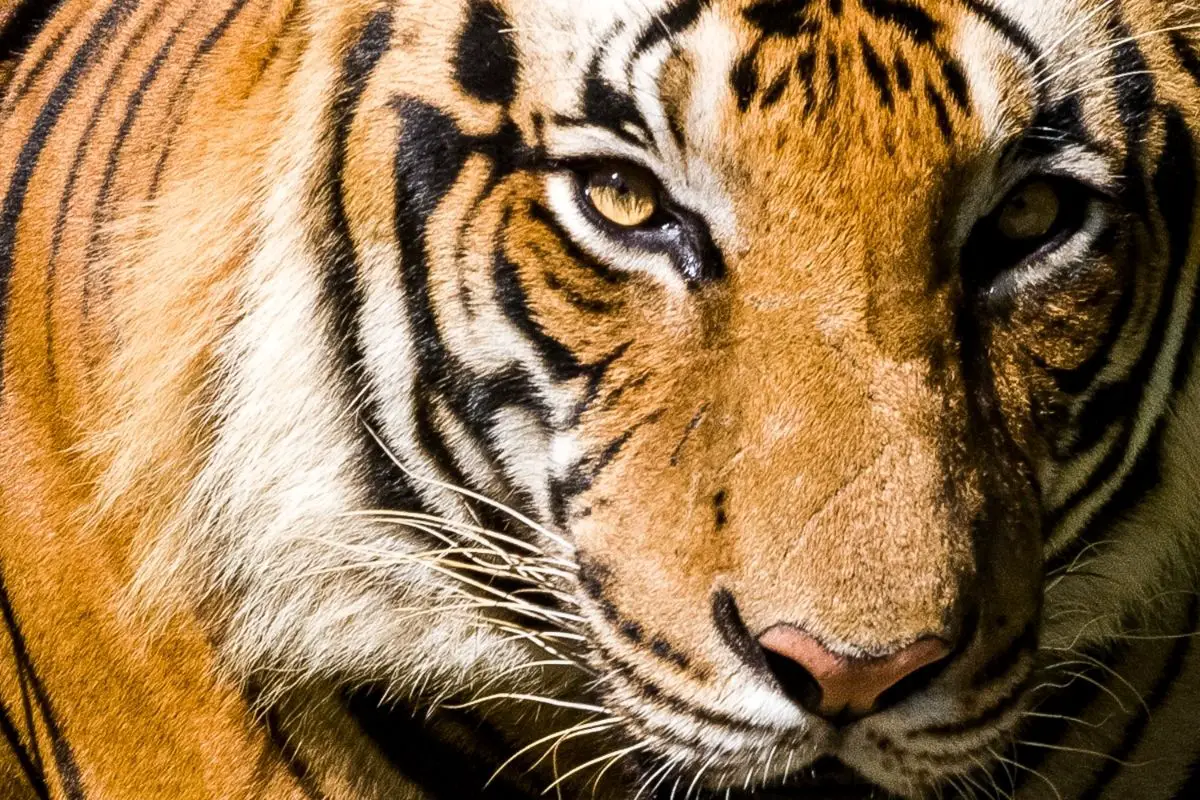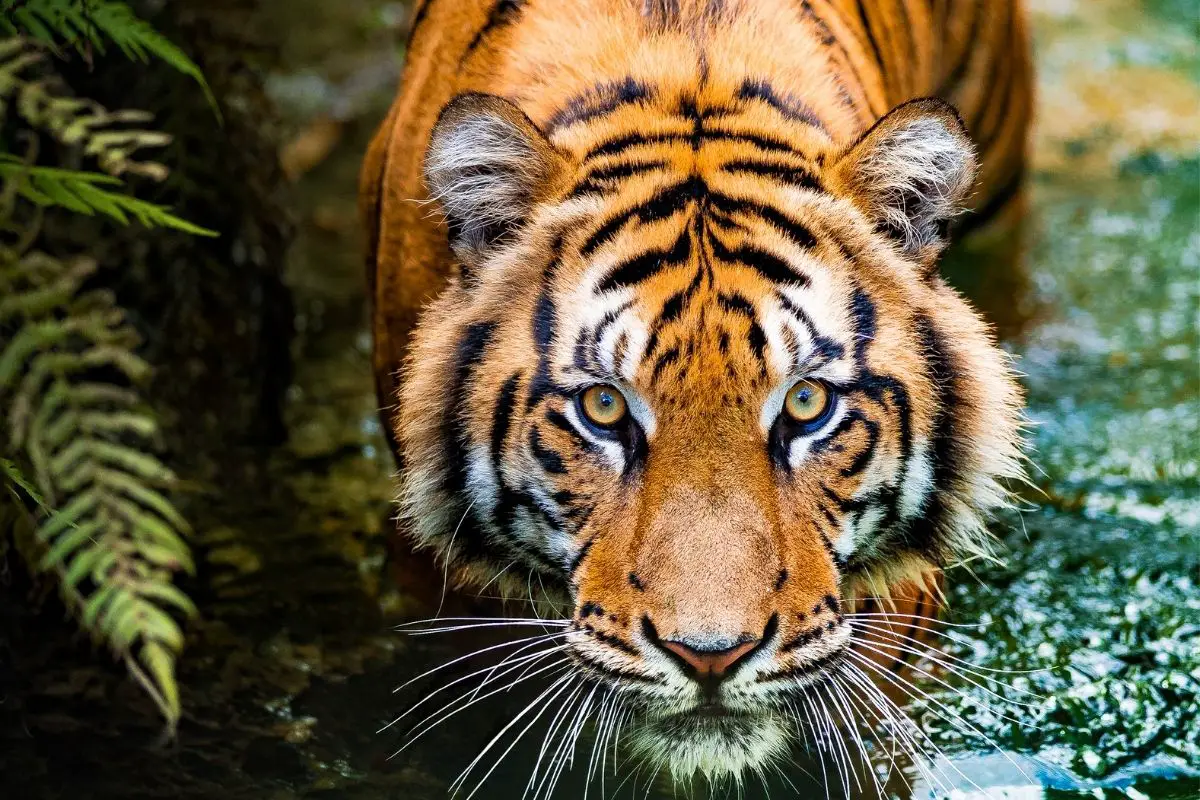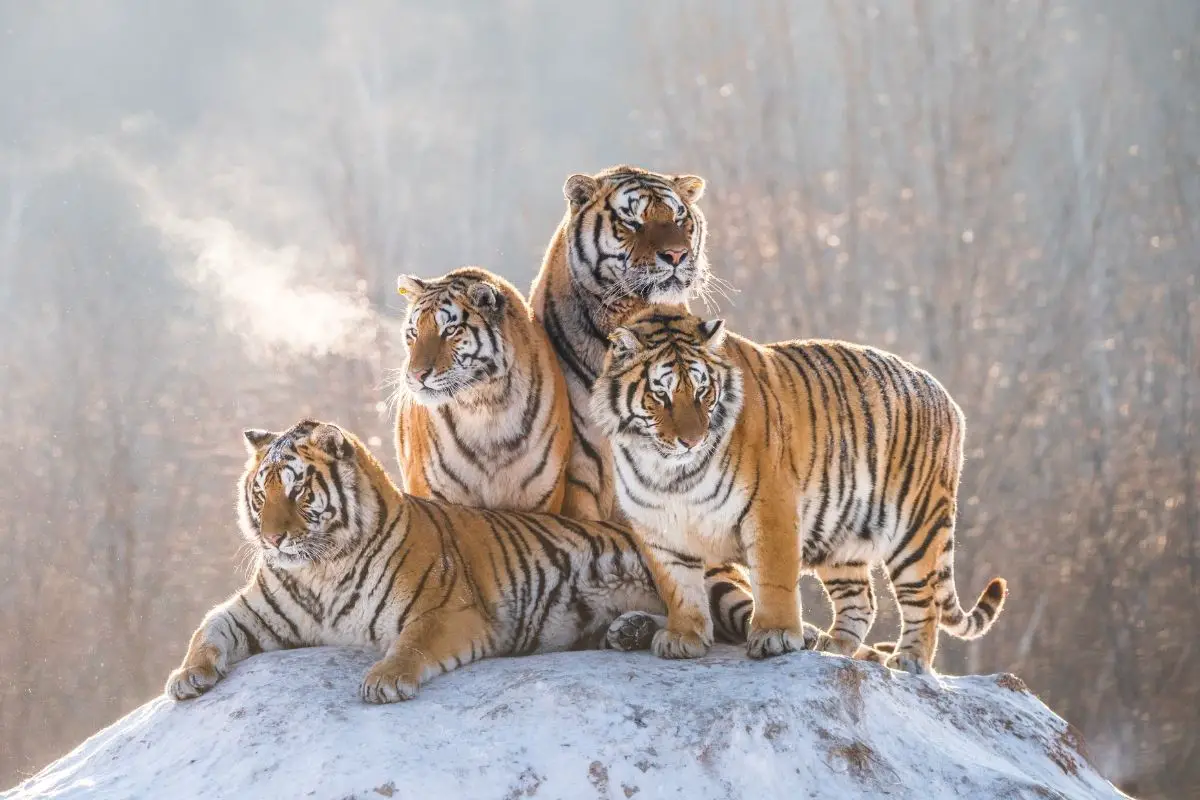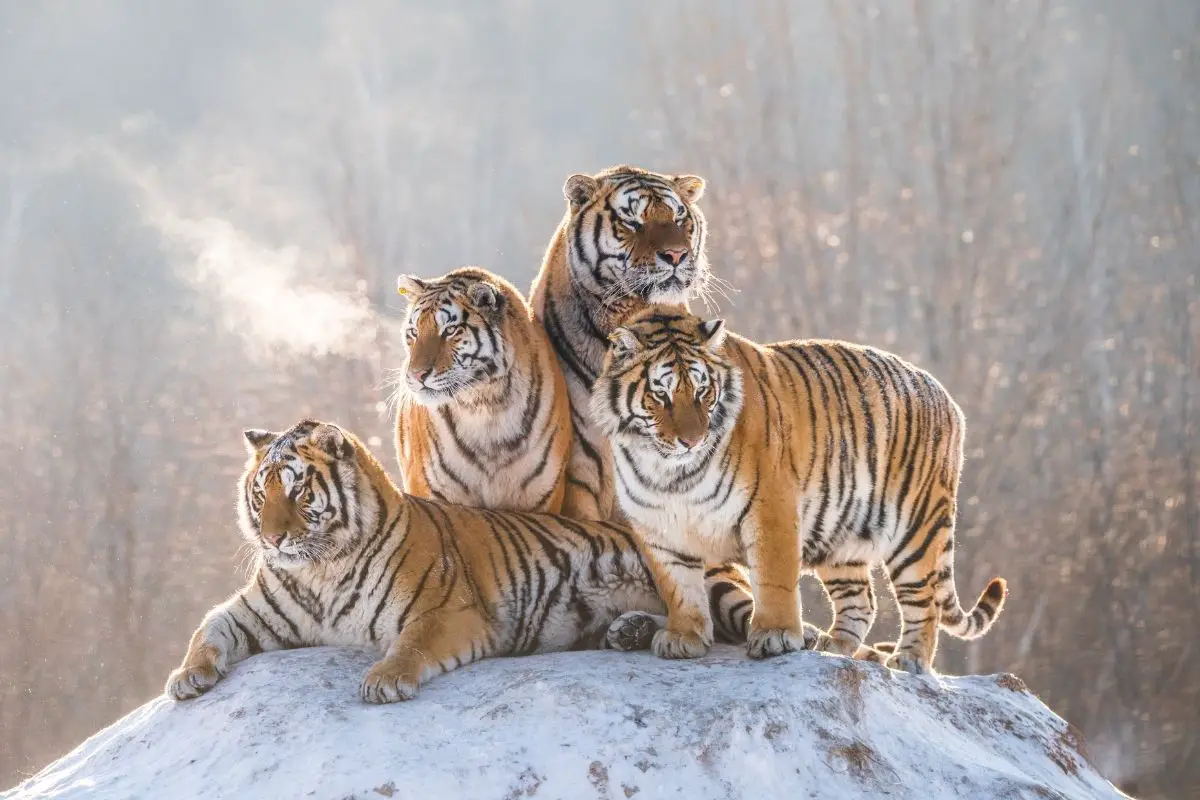Tigers are one of the most iconic big cats in the world, as well as in the whole of the animal kingdom.

They are well-known for many things, from their size and strength to their iconic striped fur. But this isn’t everything that makes tigers special, however – far from it!
In fact, tigers are incredibly fascinating animals that have many interesting and unique traits regarding both their physical attributes as well as the way they behave.
This guide has everything there is to know about a tiger’s physical characteristics and behaviors.
Here we’ll cover everything from the size and strength of a tiger and how these change as a tiger grows, to how tigers interact with each other and other animals, including humans.
We’ll also take a look at how tigers hunt and communicate, as well as some of the ways they mark their territory.
So what are you waiting for? Let’s get started!
What Do Tigers Look Like?
Physical Characteristics
Tigers are among the biggest species of big cats, with the largest species (the Amur Tiger) being the largest of all big cats.
They are known for their incredible size and strength, with adult male tigers reaching sizes between 9-10 feet long and weighing more than 500 lbs depending on the species.
Tigers are incredibly muscular, with up to 70% of their body being made up of muscle.
They also have powerful legs that help them run at 65 km/h and jump 25 feet through the air.
A tiger’s hind legs are longer than their front ones to help them jump further and give them added agility.
But while tigers are stronger than lions in terms of muscular strength, they have a lower bone density.
One of the tiger’s most iconic features is its fur. Tigers are famous for their orange-and-black striped fur, with patches of white on their stomach, face, and tail.
This striking feature sets tigers apart from other big cats and makes them instantly recognizable.
While it might easily stand out to humans against the bright greens of the tiger’s jungle habitat, it is actually an incredibly effective camouflage technique; most of the tiger’s prey has dichromatic vision (aka red-green colorblindness) which makes orange appear green, helping the tiger stay hidden!
Most species of tigers have markings in their fur on the back of their ears that form false eyes.
The reason for these false eyes isn’t fully understood; some speculate that they are used to ward off potential threats, while others believe that it is used to help cubs identify and follow their mother through the dense jungle.
Not all tigers have the same orange and black stripes, however.
Golden tigers have different shades, with their black stripes now cinnamon and their orange now the eponymous golden color.
White tigers, as the name suggests, are a bright white with black stripes (although this is a result of selective breeding and no white tigers exist in the wild).
On rare occasions, a Bengal tiger can have dark fur in different shades of black, but this is caused by a mutation in their pigmentation and black tigers aren’t their own species.
Tiger’s Size And Strength
As mentioned earlier, tigers are well known for their incredible strength.
These big cats are powerful apex predators that are capable of taking down tough prey many times its size.
A single tiger is able to kill large prey such as bears, boar, and even elephants!
Because of their power and agility, tigers can take down larger prey with ease, typically striking at the throat to take out prey in one blow.
They can do this because of their strong muscles and incredible bite force, which can have more than 1000 psi of pressure.
The Bengal tiger has a bite force of 1050 psi, which is twice that of a lion; Bengal tigers also have the longest fangs of all tigers, and their canines can measure over 3 inches in length.
What Is The Biggest And Smallest Tiger Species?
Tigers are the biggest species of big cats, both in terms of size and their weight. Not all species of tiger are the same size, though, and some are bigger or smaller than others.
Like we mentioned earlier, the Amur tiger (which is sometimes also known as the Siberian tiger) is the largest out of all tiger species.
Adult males can weigh over 600 lbs and measure up to 12 feet tall from head to tail.
Despite their incredible size, Amur tigers are also incredibly agile and are even able to take down adult brown bears (which they share a habitat with).
On the flip side, the smallest species of tiger is the Sumatran tiger. However, this tiger is still larger than many other big cat species.
It weighs up to 300 lbs and measures 8 feet from head to tail.
While it is smaller than other tiger species, the Sumatran tiger is still a deadly predator capable of hunting large prey like wild boar, crocodiles, and even rhinoceros calves!
How Tigers Grow: Juvenile To Mature
Tigers change quite a lot as they grow. Newborn tiger cubs typically weigh around 2-4 lbs, but they grow quickly.
It takes around 6 days for the cubs to open their eyes, but they will be completely blind for up to two weeks.
By the time they are one year old, a tiger cub can weigh between 150 and 200 lbs and measure 6 feet from head to tail tip.
Tiger cubs will spend most of their time playing, pouncing and chasing their siblings.
Tigers will reach their full adult size and weight when they are around 2-3 years old, at which point they will leave their mothers and establish their own territories.
Mature tigers are less energetic and playful than cubs, and instead put their energy into hunting.
An adult tiger can measure over 10 feet long and weigh more than 600 lbs of almost pure muscle, so they need to hunt and eat lots of food to survive.
Adult tigers will eat around 25 lbs of meat a day in order to sustain their powerful bodies, and wild tigers will sometimes eat over 100 lbs of food in one sitting before fasting for several days.
This translates to eating around one deer-sized animal a week, or around 50 per year!
How Do Tigers Behave?

Behavior Around Other Tigers
Like most big cats, tigers are solitary animals (in fact, lions are the only species of cat to live in groups).
Once they reach adulthood, tigers will leave their mothers and set off on their own to establish a new territory.
Tigers are extremely territorial, and will attack any other animals that encroach on their space.
This includes other tigers, and male tigers in particular will fight over shrinking territories as well as over prey.
That’s not to say tigers are completely solitary and hostile towards other tigers, however, and tigers can get along with each other at times.
For example, during mating season tigers will come together to find a mate. Tigers may also come together to share a meal after a kill, although they will only ever hunt alone.
Their territories, while not encroaching on each other, can also be near to each other.
This applies especially for female cubs, who will often establish their territory near to their mother’s.
A tiger won’t interact directly with other tigers (apart from to mate and when sharing a kill), so instead use other methods to communicate.
These include visual aids like scratching marks into trees with their claws, vocal cries to indicate their position, and (most prominently) scent markings from several scent glands around their body.
Tigers may also spread urine and feces to mark their territory.
Behavior Around Prey
Tigers are aggressive predators that will attack and kill most prey that they encounter. This includes while hunting, or when another animal encroaches on their territory.
Tigers are apex predators at the top of their food chain, and are more than capable of taking on even large and dangerous animals like crocodiles and bears.
Despite this, tigers won’t typically attack more dangerous predators that it shares a habitat with.
Tigers will coexist with leopards, bears, and wolves among others, although the tiger lies at the top of this hierarchy and is less likely to be attacked.
While they are definitely capable of taking these animals on (and frequently do), this usually only happens if there is no other easy food available or if there is a dispute over territory.
Another thing that keeps tigers from interacting with other animals is their sleep patterns.
Tigers are mostly nocturnal and will sleep for most of the day, while most of the other animals in the ecosystem are active during the day.
This keeps them from interacting with each other unless the tiger is hunting.
Behavior Around Humans
Humans and tigers typically don’t encounter each other face to face that often, mostly due to dwindling numbers of tigers in the wild.
Wild tigers are typically wary of humans and will tend to stay away. While tigers will attack humans, they will only do this if they can’t find enough food or if they feel threatened.
Tigers can also attack humans if a person enters their territory or comes too near to their cubs, as they are fiercely territorial and protective of their young.
While humans are easy prey for tigers, they prefer not to hunt them.
Tigers in captivity can be friendlier to their owners and breeders than wild tigers, but there is still a risk.
Tigers are predators and even ones in captivity will have predatory instincts, so there is always a risk that they will become aggressive.
There is also the potential risk of the tiger injuring or killing their owner accidentally; after all, they are 600 lbs of muscle with 4-inch claws.
While tigers (especially ones in the wild) are more than capable of killing a human, they will usually avoid them unless there is a specific reason like a lack of food or invasion of territory.
Otherwise, tigers will steer clear of humans for the most part.
How Do Tigers Communicate?
While tigers steer clear from other animals (including other tigers) for the most part, there are still situations where they will need to communicate with each other.
The most common times where tigers communicate with other animals is between a mother and her cubs or during the mating season when groups of tigers come together.
Tigers will also communicate with other predators that it coexists with, either to establish dominance or to mark their territory, as well as communicating indirectly through markings.
Tigers communicate in several ways. Here is a breakdown of the ways that tigers communicate with other animals.
Vocal
One of the most direct forms of communication a tiger has is its roar. This is a terrifying noise that can be heard over 3 kilometers away!
Tigers will roar to mark their territory, announce their presence, and to intimidate other predators and other tigers.
It can also be used to attract mates and invite them to their position.
Tigers can also growl and hiss to show aggression and establish dominance, as well as to ward off potential threats.
Growls and hisses are often used together as a way to tell other animals to back down, either from their territory, food, or cubs, and are frequently used as a last resort before attacking.
Tigers don’t just use vocalizations to show aggression, however, and there are several other noises that tigers make depending on their mood.
Unlike domestic cats, tigers are unable to meow. Instead, they make a noise known as ‘chuffing’, which is a snort-like sound made by blowing a burst of air through the nostrils.
This produces a loud, breathy snort, also known as a prusten.
Chuffing is an exclusively non-threatening sound, and is used as a greeting for mates or by a mother comforting her cubs.
It is also used as a general greeting for other tigers as a sign of non-aggression; in captivity, tigers may chuff at their owners/breeders.
Another sound that tigers make is a moaning noise, somewhere between a whine and a gentle roar.
This happens when tigers want attention or are bored, and can also be a sign that the tiger is in a bad mood.
Tigers will also use contact calls, a type of roar that is used to signal their location. These are used both in the wild and in captivity.
Contact calls aren’t necessarily aggressive, but are used as warnings to other tigers and predators to avoid any unwanted encounters.
Visual And Body Language
When visual communication is necessary, tigers mostly rely on body language. The tail is one of the clearest visual communicators and is very indicative of the tiger’s mood.
An agitated tail means the tiger is agitated, and a relaxed tail means the tiger is relaxed.
Tigers can also use their paws to show agitation or aggression, scratching and stomping on the ground.
Bared fangs are a clear sign of aggression and usually preface an attack.
This is usually accompanied by growls and hissing, and can also be used to make threats (such as other tigers) back down.
When a tiger is angry or defensive its hackles will raise and it will prepare its body to leap and attack.
A happy and relaxed tiger will have a loosely-hanging tail and relaxed body.
They will squint or close their eyes, which tigers only do when they feel happy and safe as it lowers their field of view and reduces their defenses.
A content tiger might also bob its head as it chuffs.
Tigers also use indirect visual communication methods, primarily to mark their territory.
As mentioned earlier, tigers will scratch marks into trees and rocks to mark out their territory, and may also spread their feces around for the same reason.
Scent
One of the primary forms of communication that tigers use is through scent.
Tigers use scent to mark their territories and attract mates, as well as to ward off threats such as other tigers and predators such as wild dogs and bears that hunt tiger cubs.
Scent is also used to help cubs track their mother and for tracking different individuals.
Tigers have many scent glands across their body, including on their paws, tail, face, whiskers, and anus.
These produce a smell that will linger on surfaces for several weeks.
Tigers will mark their territory and belongings by rubbing up against trees and stones, leaving their scent behind.
The scent left by a mother tigress’ paws will also help her cubs keep track of their mother and guide them to her.
Tigers have individualized scents that make it easy for other tigers to identify each other, allowing them to track their mates, cubs, and mothers.
Tigers also use their urine and feces to mark territory, as the strong smell associated with these can last over two months.
This isn’t just used for the smell’s potency, however, and the strength of the odor can be used to communicate several things to other tigers, such as how long ago the tiger passed through and whether or not the territory is currently occupied.
Territory And Hunting

How Do Tigers Mark Their Territory?
As mentioned previously, tigers use several different methods to indicate the territory that they have established.
These include visual, vocal, and olfactory means of communication that are used to mark their territory for other tigers and to deter the presence of other animals.
Tigers will scratch markings into trees and stones around the area, using their sharp 4-inch long claws to gouge notches around their territory.
They will also use contact calls and roars to indicate their position and make other animals aware of their presence, as well as to deter unwanted guests.
Contact calls are typically used to alert other tigers of their territorial boundaries, while roars are a more direct form of communication that essentially translates to “get out while you still can”.
Finally, the most important way that tigers mark their territory is through the use of scent.
A combination of odors from a tiger’s scent glands and urine can linger for several months and is highly effective at keeping other animals out as well as indicating whether the area is occupied.
How Big Is A Tiger’s Territory?
The size of a tiger’s territory mostly depends on the species, and this can vary greatly depending on what species the tiger is and where it lies geographically.
Several factors influence the size of a tiger’s habitat, and this can prove both useful and harmful to the tiger depending on its environment.
Some of the biggest factors when it comes to the size of a tiger’s territory include the size of the tiger, along with the available space, the population density of other predators in the area, and the prevalence of available food to hunt.
Tiger territories can vary drastically in size. In general, areas with an abundance of prey mean that the tiger needs less space, as there is enough food available in a smaller space.
By contrast, habitats without many animals available to hunt mean that more territory is necessary for each tiger.
Sumatran tigers typically have more prey and other resources available in a smaller space, and males will have territories ranging up to 150 sq km.
Amur tigers, on the other hand, face a far more sparsely populated and barren environment, requiring more territory; male Amur tigers can have territories spanning anywhere from 800 to 1300 sq km.
Males have larger territories than females, and spend a lot of their time patrolling their territory to defend against threats and invaders.
Females, on the other hand, have smaller territories but focus their efforts on making this suitable for their cubs.
Tigresses can form overlapping or adjacent territories with their mothers after separating, and males will occasionally make their territories overlap with multiple females’.
One of the biggest things affecting the size of tiger territories is shrinking habitats.
The rise of human activity and growing population means that tigers are having less and less space to live in the wild.
This means that there is scarcer resources and more competition for territory, and some tigers are left with a territory too small for them.
Territory size can also be affected by migration patterns of prey, weather conditions, and even the changing seasons!
How Do Tigers Hunt?
As mentioned earlier, tigers like to take down their prey with a single strike to the throat.
Tigers don’t just rely on their immense strength and agility to hunt, though, and this is usually just reserved for the takedown.
Instead, tigers rely mostly on their stealth while hunting their prey.
Tigers are incredibly adept at being stealthy and can move almost silently through the jungle undergrowth.
Combined with their incredible camouflage that helps them blend right in with their jungle backdrop, tigers are able to sneak up on their prey completely unnoticed.
Typically, a tiger will sneak up on its prey and lie in wait until the perfect moment.
When this comes along, they will leap at their prey using their powerful legs and clamp their jaw around the throat; a tiger’s jaws are incredibly strong and it’s nearly impossible to get a tiger off after it’s clamped its jaws around something, and it will either crush the prey’s throat entirely or wait there until the prey is dead.
While not typically used for most of a tiger’s hunting, they can still put their power and agility to good use.
Tigers can run at speeds up to 60 km/h in short bursts, which makes them more than capable at keeping up with or overtaking most prey.
They are also great climbers that can scale trees and rocky outcrops with ease, while their powerful legs let them jump up to 20 meters in height and almost 30 meters horizontally from a sitting position.
Tigers are also adept swimmers, which helps them travel along rivers in order to catch fish, crocodiles, and species of aquatic snakes such as the green anaconda.
Their webbed toes and powerful muscles allow them to swim for over 20 kilometers at a time even while carrying large prey.
Final Thoughts
Tigers are incredible animals with fascinating physical characteristics and behaviors.
These big cats are special for many reasons, from their unique fur markings to their incredible physical attributes like their size, strength, and agility.
There are many reasons to love tigers, and their physical characteristics and behaviors are just a few of the things that make tigers stand out among other big cats.
We hope you’ve enjoyed learning more about a tiger’s physical characteristics and attributes, from how tigers look to how they behave.
There is so much to know about tigers, and these fantastic big cats never fail to amaze.
As the largest species of big cats, tigers definitely stand tall as the true kings of the jungle!
- Sink Your Teeth Into This: Analyzing the Powerful Lion Bite Force - September 8, 2023
- Siberian Tigers: Everything You Need To Know - September 4, 2023
- Do Lions Eat Humans? Understanding Lion Aggression and Risks - September 4, 2023








